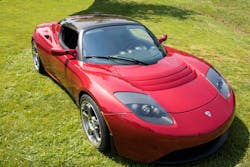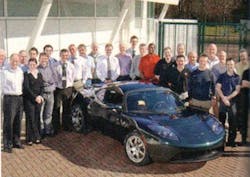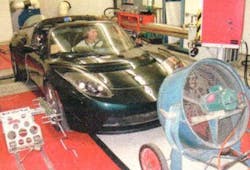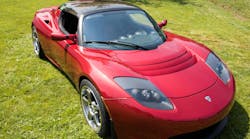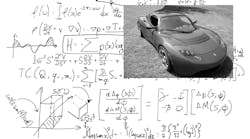Tesla Motors created quite a stir when it announced its all-electric Roadster in 2006, with 250 miles per charge and 0- to 60-mph acceleration in 4 seconds. Critics were quick with their skepticism. But in September, the company put its Validation Prototype 1 (VP1) to the test, confirming these claims with only some slight modifications (Fig. 1).
According to Tesla vehicle systems engineer Andrew Simpson, the company upgraded the VP1 to meet production standards. Among other tweaks, the motor and power electronics module (PEM) cooling were improved to increase thermal headroom and reduce the need for active cooling. Designers also installed a brand new Energy Storage System (ESS) battery pack that's baseline-tested and confirmed against the company's production specification.
"I then drove VP1 more than 1000 miles in representative real-world conditions to wear in the new components, prior to testing, as required by federal procedures for range certification," said Simpson. "These miles included impatient commuting in the suburbs, sustained aggressive driving on the highways, and (most fun of all) sporty driving in the hills around San Francisco."
Punching it The team headed to Moffett Field at NASA's Ames Research Center in Sunnyvale, Calif. Simpson took the VP1 out on a 1.5-mile runway with a gentle slope, zooming up and down the tarmac in both directions. Onboard computers logged the car's speed data while standalone instruments provided backup and confirmation.
"I shifted to first, punched the throttle, and the car rocketed easily to 60 mph in less than 4 seconds," Simpson said. "I had mistakenly left traction control enabled, so there were no squealing tires nor the smell of burning rubber. But had I switched traction control off, we might have reached 60 mph even faster (albeit more dramatically)!"
Simpson reached a top speed of 130 mph and maintained it for half a mile. However, he said, such sustained speeds subject the drive motor to extreme mechanical and thermal stresses. Tesla will electronically limit the production Roadster's top speed to 125 mph to maintain long-term reliability in the powertrain.
More miles For mileage testing, the team headed to Automotive Testing and Development Services in Ontario, Calif., and strapped the VP1 to one of the facility's dynamometers. A steel roller on the dyno connects to an electric generator, which provides an opposing force to simulate the vehicle's weight (inertia) and friction (drag). A professional driver operated the vehicle to control the accelerator, brake pedals, and gear shift (Fig. 2).
Using EPA guidelines, Tesla achieved a city driving cycle of 252 miles with recharge energy of 30 kWh per 100 miles. The company also achieved a highway driving cycle of 236 miles with a recharge energy of 32 kWh per 100 miles. Combined, that's 245 miles with a recharge energy of 31 kW/h per 100 miles - not too far from those initial 250- mile claims for a single charge.
Over the last few months, Tesla engineers have taken VP models out cruising in northern California to prove ranges for a single charge in a variety of driving styles. In a best-case scenario, the car enjoyed 267 miles of conservative urban driving in the suburbs around San Carlos.
Drives also included a 230-mile run from North Lake Tahoe to San Carlos with two occupants plus luggage. The team tallied 186 miles of aggressive driving on I-280 and the round trip from Woodside to San Gregorio Beach via Highway 84. And a commuter nightmare saw 165 miles of impatient driving with aggressive stops and starts, high speeds, and air conditioning from Saratoga Gap to San Carlos via highways 9 and 85 and I-280.
Sign up now! "We had previously indicated our testing suggested that range would likely come in closer to 200 miles per charge. But we have been working diligently to improve this very important characteristic and are now quite pleased with the results," said Michael E. Marks, Tesla Motors CEO. "Additional testing confirms that we can take weight out of the battery pack, which should improve range."
Also, Tesla announced that it has established a production goal of 50 Roadsters for the first quarter of 2008, followed by an additional 600 cars for the remainder of the year. While the company already has filled its reservations for 2008, interested drivers can put down a deposit of $5000 to get on the waiting list for remaining 2008 Roadsters or be first in line for the 2009 models when they become available.
